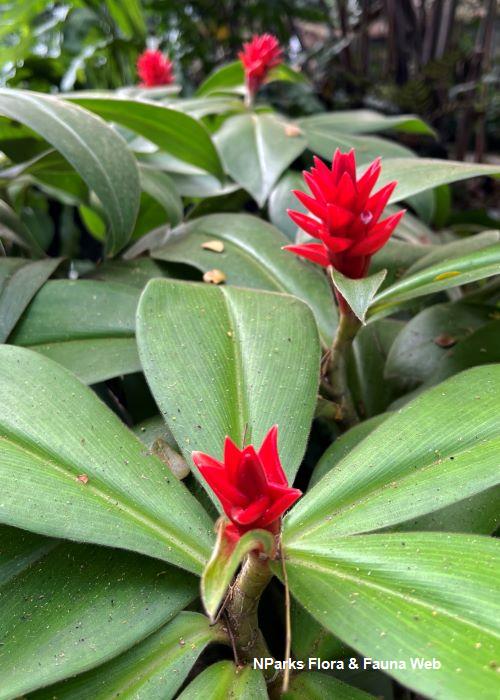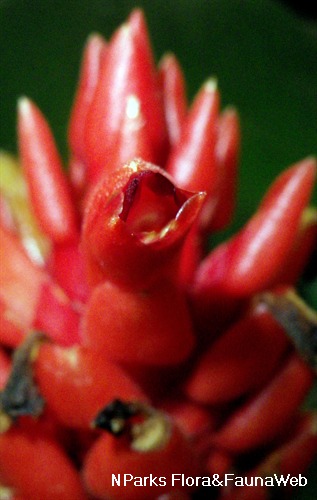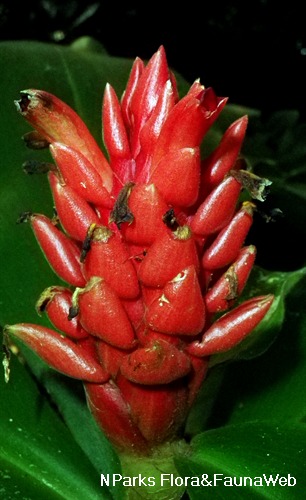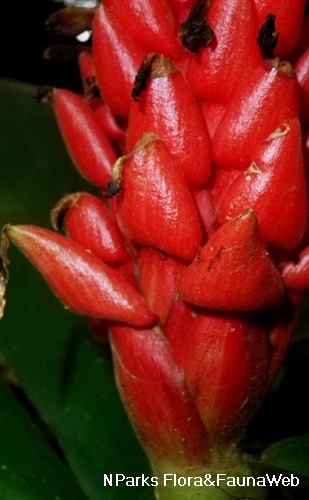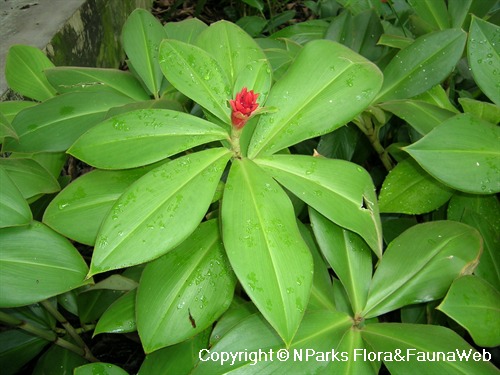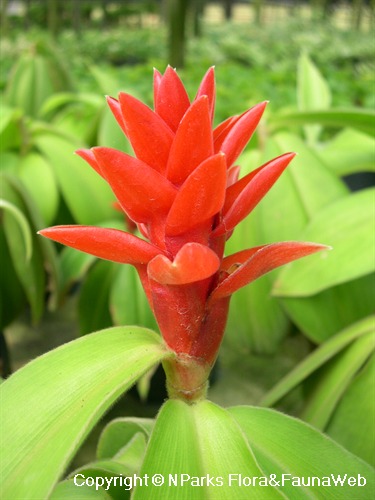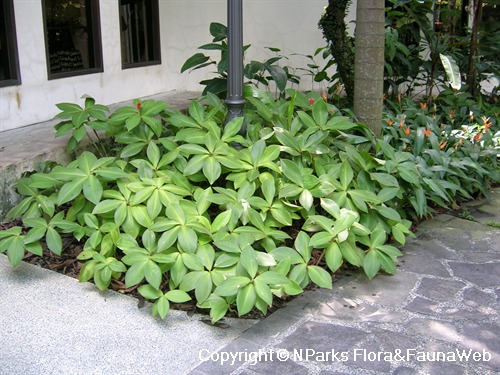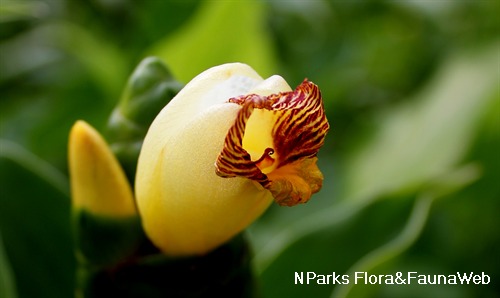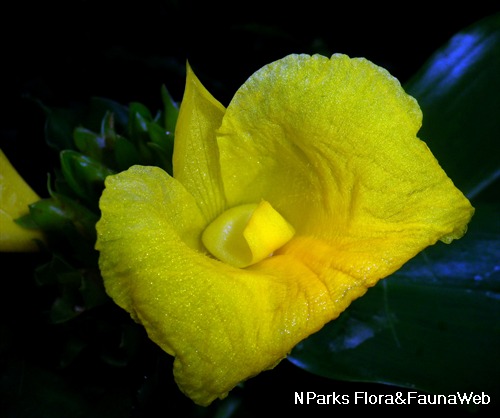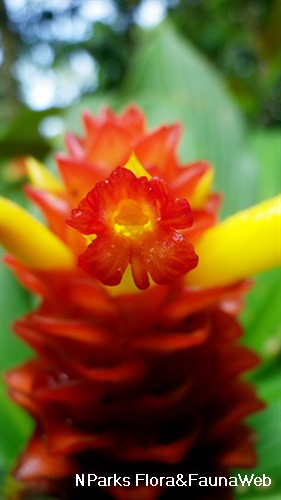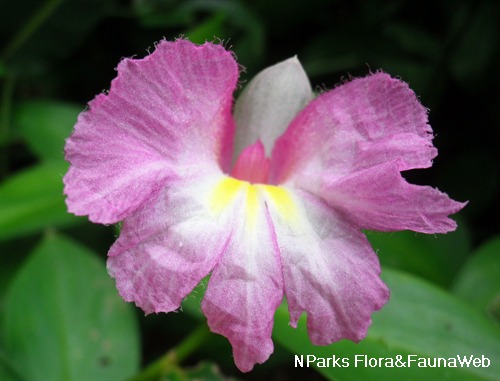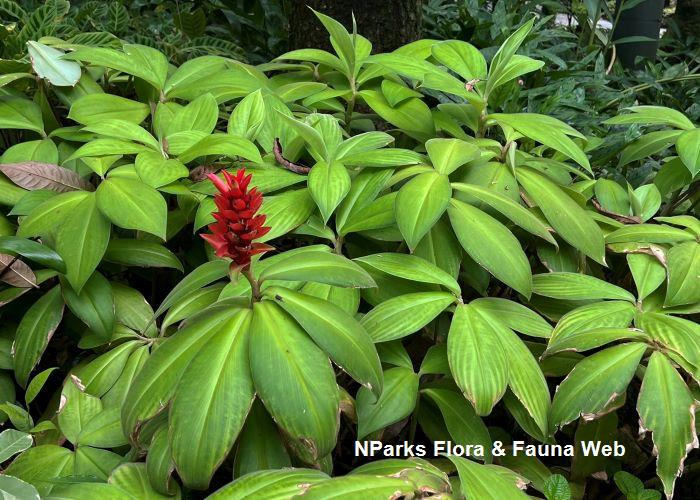
Back
Costus osae Maas & H.Maas
| Family Name: | Costaceae |
| Common Name: | Red Rose Ginger |
The Red Rose Ginger (Costus osae) is a spiral ginger that produces red bracts and flowers. It is an herbaceous, rhizomatous plant with green, velvety leaves arranged in a spiral towards the tip of its shoot, resembling a spiral staircase.
Name
Classifications and Characteristics
| Plant Division | Angiosperms (Flowering Seed Plants) (Monocotyledon) |
|---|---|
| Plant Growth Form | Herbaceous Plant |
| Lifespan (in Singapore) | Perennial |
| Mode of Nutrition | Autotrophic |
| Maximum Height | 0.5 m to 1.2 m |
Biogeography
| Native Distribution | Costa Rica |
|---|---|
| Native Habitat | Terrestrial (Primary Rainforest, Riverine) |
| Preferred Climate Zone | Tropical |
| Local Conservation Status | Non-native (Horticultural / Cultivated Only) |
Description and Ethnobotany
| Growth Form | It is a herbaceous, rhizomatous plant that grows up to 1 - 1.2m tall. |
|---|---|
| Foliage | The leaves are obovate to elliptic, up to 29 cm long and 16 cm wide, covered in a dense layer of soft hair on both sides, and with a sunken midrib. Upper surface of the leaf is bright green, and lower surface is pale dull green. Leaves are clustered towards the end of the green shoot in a spiral arrangement. Leaf bases have a closed sheath with a ligule (projection at the top of the leaf sheath) up to 9 mm long. |
| Stems | It has an underground rhizome (thick, horizontal modified stems) that produces green aboveground stems at regular intervals. |
| Flowers | The inflorescence resembles a pine cone with dull red, outwards-pointing bracts. Bracteoles are reddish but hidden by the bract. Flowers are tubular with red calyx and corolla. The lip and lateral lobes are ovate and similar in appearance. |
| Fruit | The fruit is an obovoid capsule (a type of dry, dehiscent fruit) containing miniature seeds. |
| Habitat | It grows along steep hillsides near rivers and creeks in primary rainforests at 0 to 400 m above sea level. |
| Similar | Costus osae vegetatively resembles C. elegans (= C. malortieanus) but can be differentiated by its pine cone-like inflorescence, red flowers and bracts, and a longer ligule. |
| Associated Fauna | In Singapore, sunbirds have been observed visting the flowers and inflorescence but in its native habitat, it is pollinated by hummingbirds. |
| Taxonomy | Despite being a species, this plant is still occasionally sold as the trade name, Costus 'Red Rose'. |
| Cultivation | It grows well in fertile, well-draining soil and semi-shaded conditions. Avoid exposing in the hot afternoon sun. If the soil is kept too moist, leaves may develop fungal spots. It can be propagated by division and rhizomes. |
| Etymology | The species epithet osae refers to the Osa peninsula in Costa Rica, where the plant was originally discovered. |
Landscaping Features
| Desirable Plant Features | Ornamental Flowers, Ornamental Foliage |
|---|---|
| Landscape Uses | Flowerbed / Border, Container Planting, Parks & Gardens, Small Gardens |
| Thematic Landscaping | Bird & Wildlife Garden |
Fauna, Pollination and Dispersal
| Fauna Pollination Dispersal Associated Fauna | Bird-Attracting (Flowers) |
|---|---|
| Pollination Method(s) | Biotic (Fauna) (Vertebrates (Bird)) |
Plant Care and Propagation
| Light Preference | Semi-Shade |
|---|---|
| Water Preference | Lots of Water, Moderate Water |
| Plant Growth Rate | Moderate |
| Rootzone Tolerance | Fertile Loamy Soils, Well-Drained Soils, Moist Soils |
| Maintenance Requirements | Moderate |
| Pest(s) | Sucking Insects, Nematodes |
| Propagation Method | Division, Stem Cutting, Storage Organ (Rhizome) |
Foliar
| Foliage Retention | Evergreen |
|---|---|
| Mature Foliage Colour(s) | Green |
| Mature Foliage Texture(s) | Velvety / Furry / Tomentose, Thick |
| Foliar Modification | Flower/Fruit Bract |
| Foliar Type | Simple / Unifoliate |
| Foliar Arrangement Along Stem | Spiral |
| Foliar Shape(s) | Non-Palm Foliage (Obovate, Elliptical) |
| Foliar Venation | Parallel |
| Foliar Apex - Tip | Acute |
| Foliar Base | Acute |
| Typical Foliar Area | Mesophyll ( 45cm2 - 182.25 cm2 ) |
| Leaf Area Index (LAI) for Green Plot Ratio | 3.5 (Shrub & Groundcover - Monocot) |
Non - Foliar and Storage
| Stem Type & Modification | Herbaceous |
|---|---|
| Root Type | Underground (Fibrous Root) |
| Specialised Storage Organ(s) | Underground (Rhizome) |
Floral (Angiosperm)
| Flower & Plant Sexuality | Bisexual Flowers |
| Flower Colour(s) | Red |
|---|---|
| Flower Grouping | Cluster / Inflorescence |
| Flower Location | Terminal |
| Flower Symmetry | Bilateral |
| Individual Flower Shape | Tubular |
| Inflorescence Type | Spike |
| Ovary Position | Inferior / Epipgynous |
| Flowering Period | Free-Flowering |
| Flowering Habit | Polycarpic |
| Flower Colour(s) Remarks | Dull red bracts |
Fruit, Seed and Spore
| Fruit Classification | Simple Fruit |
|---|---|
| Fruit Type | Dehiscent Dry Fruit , Capsule |
References
| References | Mass, P. L. M. & H. Mass-van de Kamer. (1997) Two new species of Costus (Costaceae) from Costa Rica. Brittonia 49(2): 274-279 |
|---|
Image Repository
Others
| Master ID | 8102 |
|---|---|
| Species ID | 3314 |
| Flora Disclaimer | The information in this website has been compiled from reliable sources, such as reference works on medicinal plants. It is not a substitute for medical advice or treatment and NParks does not purport to provide any medical advice. Readers should always consult his/her physician before using or consuming a plant for medicinal purposes. |

